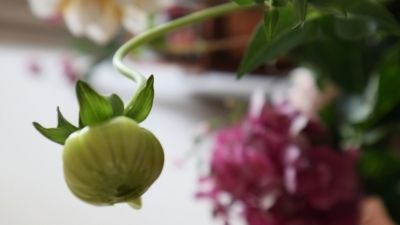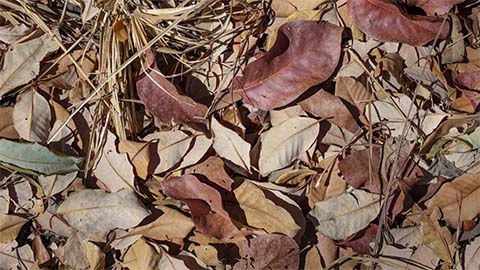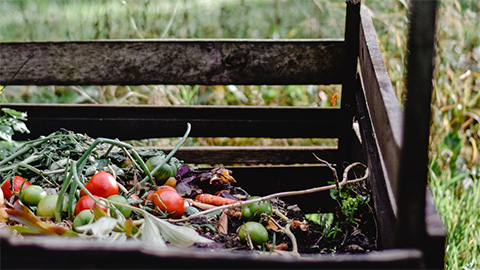Raspberry Management for Utah
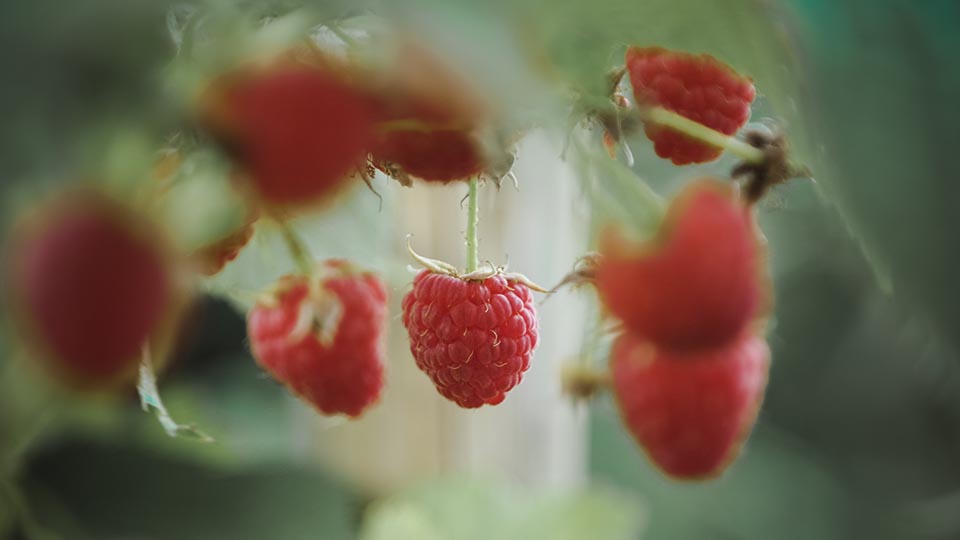
Raspberries
Raspberries are a favorite fruit for many Utahns. The plants can be grown across much of Utah, but require special care in some areas. With proper planning, management and care, a raspberry planting can provide fresh fruit for many years. This fact sheet will provide a general guide to raspberry production that can be adapted for both home use and for small-scale commercial production.
Plants
Raspberry plants have a perennial root system. However, cane growth is biennial. This means that an individual cane typically lives only 2 years and then dies. New canes emerge from the roots in the early spring and continue growth throughout the summer. Second-year canes do not grow taller, but grow short lateral branches containing several leaves and a terminal flower cluster that leads to fruit formation. After producing fruit, the second-year canes die. A first-year cane is called a primocane, and the second-year cane is called a floricane. While the floricanes are producing fruit, primocanes are developing and will become the next year’s fruiting floricanes. In this way, the planting may produce fruit every year.
Some cultivars will produce flowers and fruit on the upper portion of the primocanes (first year canes) in the fall. For these “primocane-fruiting” types, the primocane ceases growth in mid-summer, with lateral buds opening to form fruiting side shoots, beginning at the tip and progressing down the cane. Typically, the buds in the top third to top half of the cane produce flowers and fruit before the plants go dormant for the winter. The remaining lower portion of the cane still has the potential to produce a floricane crop during the following season. These primocane-fruiters are also referred to as fall-bearing, ever-bearing or doublecropping. Primocane-fruiting types require somewhat different management than the summer-bearing (floricane-fruiting) types that will be discussed below.
Cultivated raspberries can have red, black, yellow or purple fruit color. Raspberries are self-fruitful and are pollinated by insects or wind. Along the Wasatch Front and in Utah’s Dixie, fall-bearing raspberries tend to be better adapted, as the fruit ripens after the hottest part of the summer is over, thus avoiding fruit sunburn. For higher elevations with colder climates, the growing season is typically too short for fall-bearing types, so summer-bearing raspberries are better adapted. For these locations, it is important to select cultivars with good cold hardiness, as winter injury to the canes will result in crop loss.
Raspberry Plant Selection
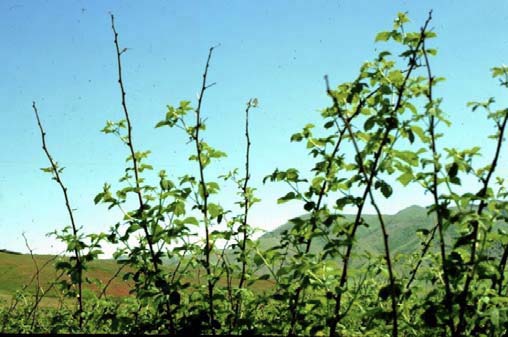
Although it is a fairly common practice to share raspberries plants with neighbors, it is best to avoid this to prevent the spread of plant viruses and soil-borne diseases. Money saved in free plant material will not be worth the problems of trying to rid your planting of disease. It is best to obtain plants that are true to name and that are free of known diseases by purchasing certified virus-free plants from reputable nurseries.
Place catalog orders or reserve plants at local nurseries early in the season to get the best varieties. Specify a shipping date to allow planting at the right time. Planting bare-root plants in the spring is better than using potted plants later in the season, as potted starts are more expensive and the quality is often inferior. Dormant bare-root plants can be planted as soon as the ground can be tilled in the early spring. Selecting cultivars that perform well in your area is critical. Some cultivars cannot survive severe freezes and significant winter damage can occur. Figure 1 shows an example of raspberry canes with partial die-back resulting from winter injury.
Raspberry Summer-bearing
Summer-bearing raspberries only produce fruit on the second-year canes (floricanes). Primocanes can grow 4 to 8 feet the first year under ideal conditions. The canes flower and produce fruit in the second year. Figure 2 illustrates the typical life-cycle of a summer-bearing raspberry. The middle three-fifths of the canes usually produce the largest quantity of fruit, and often the bestquality fruit. Fruit production starts in June and continues to the end of July, depending upon the cultivar and weather conditions.
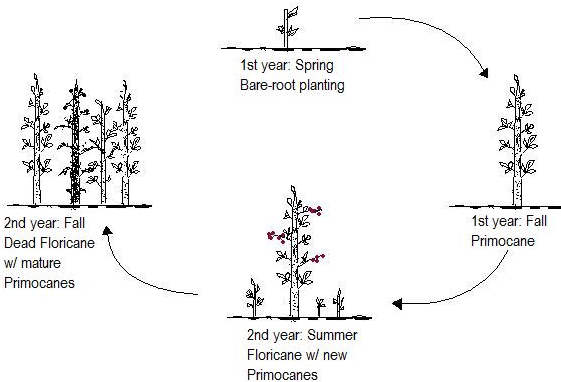
Table 1 lists several summer-bearing raspberry cultivars that have performed well in Utah. Cultivar selection is critical for a successful raspberry operation. When selecting a cultivar consider these factors. If you know of a raspberry disease that has affected your area, try to find a cultivar with resistance to that disease. Utah has harsh winters that can cause significant winter die-back in many cultivars. If you live in an area where winter injury is a concern, look for cultivars that have good cold hardiness. For more detailed information on summer-bearing raspberry cultivars in Utah see USU fact sheet Horticulture_Fruit_2015-02pr.
| Table 1. Summer-bearing raspberry cultivar recommendations. | ||||
|---|---|---|---|---|
| Cultivar | Size | Flavor | Yield | Cold Hardiness |
| Canby | Med. | Excellent | High | Fair |
| Cascade Delight | Large | Excellent | High | Good |
| Cowichan | Med. | Good | High | Good |
| Killarney | Large | Good | Med. | Fair |
| Reveille | Large | Good | High | Good |
| Jewel (Black) | Small | Excellent | High | Fair |
| Royalty (Purple) | Large | Fair | High | Excellent |
Raspberry Fall Bearing
Fall bearing raspberry primocanes emerge from the soil in early spring, but stop terminal growth and begin flowering in mid-summer, with fruit harvest beginning in late summer or early fall and continuing until the first fall freeze causes the plants to stop bearing fruit and begin dormancy. The height at which fruiting begins depends on the cultivar and the vigor of the plant. As shown in Figure 3, if canes are not completely removed during winter pruning, the lower portion of the remaining cane will produce a summer floricane crop the following season. The yields for the primocane crop depend on earliness and when the first fall freeze comes. In areas with a growing season less than 125 freeze-free days, primocane yields may not be sufficient to justify planting these cultivars.
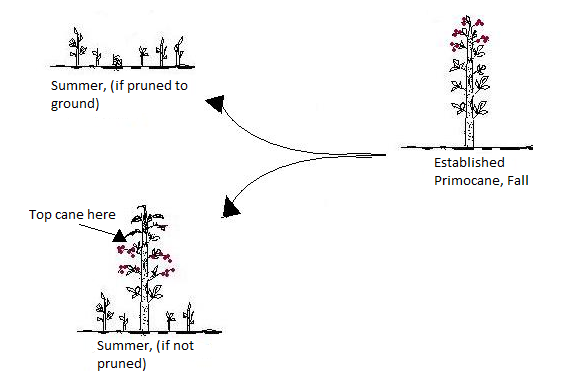
Table 2 lists fall-bearing raspberry cultivars that grow well in Utah. For more detailed information on fallbearing cultivars in Utah see USU fact sheet Horticulture_Fruit_2013n-01pr.
| Table 2. Fall-bearing raspberry cultivar recommendations. | ||||
|---|---|---|---|---|
| Cultivar | Size | Flavor | Yield | Season |
| Caroline | Large | Good | Med. | Mid |
| Josephine | Med. | Excellent | Med. | Late |
| Polana | Med. | Good | Med. | Early |
| Joan J | Large | Excellent | High | Early |
| Polka | Large | Excellent | Med. | Very Early |
Raspberry Establishment
Spacing
Raspberries grow by root suckering, as shown in Figure 4, and have a tendency to spread if not kept in check. Raspberries should be strip cultivated or side pruned annually to maintain row widths. Rows should be no wider than 2.5 feet to allow for adequate light penetration. More narrow rows give higher yields and larger berries per square foot. Distance between the rows should be determined based on equipment width, but typically should not be less than 8 feet. Allow sufficient space for hand cultivation or tilling between the rows, as well as room to maneuver during harvest. Initial in-row spacing should be 1.5 to 2 feet, to allow rows to fill in quickly.

Site Selection
Choose a location with at least 8 hours of direct sunlight to plant raspberries. Although some air movement to hasten leaf drying is important for keeping disease occurrence low, provide protection from strong winds that can increase winter damage through desiccation, damage leaves, and increase berry drop. It is a good idea to avoid planting in a site that has recently had cane berries, solanaceous crops (tomatoes and peppers), or fruit trees. This is to reduce potential infection by soilborne pathogens.
In the hot summer conditions of the Wasatch Front, fruit sunburn is a common problem which shows up as a bleached appearance on the sun-exposed portion of the fruit, see Figure 5. This damage can be minimized by planting the patch where it receives some afternoon shade, such as on the east side of a fence or building. Some commercial farms use shade cloth over the patch during fruit ripening to reduce sunburn.
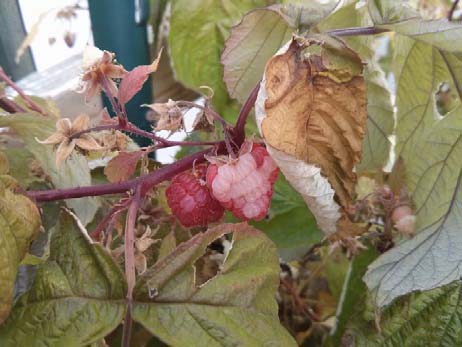
Soil Preparation
Soil is one of the most important factors to consider before planting raspberries. Raspberries require welldrained soils. Most of the roots are in the top 20 inches of soil and are easily damaged by overwatering. Before planting, add organic matter to improve soil drainage and nutrient holding capacity. In heavy soils, planting on raised beds can also help improve water drainage out of the top of the bed. A bed about 10 to 12 inches high is sufficient. Raspberries prefer a soil pH of 5.5 to 7.0, which is lower (more acidic) than is typical of Utah soils. Iron chlorosis often results from this, (see below). Modifications and amendments can be made to the soil that will help manage alkaline soils.
Weed control, particularly of perennial weeds, before planting is critical as a raspberry planting will be in the same place for many years and most herbicides used to control perennial weeds cannot be used on raspberry plantings without damaging the crop.
Planting
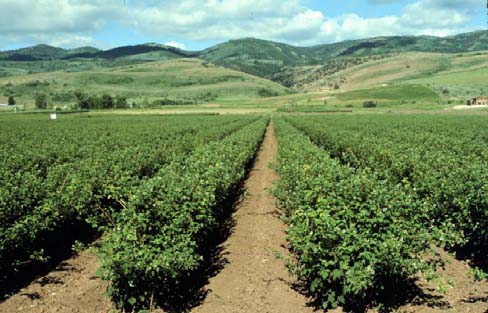
Plant dormant bare-root raspberries as early in the spring as possible, once soil moisture content is such that plowing or disking results in few clods. It is important to never let bare-root plants dry out. Immediately before planting, soak the roots in water for 1 to 2 hours. Plant them at the same level they were planted before (a soil line should be visible), taking care to cover the crown of the plant with soil. Spread roots out laterally along the row and water immediately. Some nurseries also sell plug plants, already rooted plantlets. These are typically more expensive per plant than bare-root plants but are less at risk of drying out and establish easily.
Raspberry Management
Care
Water management is critical for the first 6 weeks after planting. Keep the soil moist but not waterlogged. Most soils need water every 5 to 7 days during establishment. Do not add fertilizer when planting, as excess fertilization damages the roots or can stimulate excessive top growth before the roots develop. Control weeds since they will compete for water and nutrients, and can harbor pests. Planting grass alleyways or mulching between rows can help control annual weed problems. Avoid excessive cultivation around young plants to protect developing roots. Herbicides can help control weeds, but take extreme care when using systemic herbicides, as raspberries are very sensitive and can easily be damaged by unintended drift. Pre-emergent herbicides applied in the spring will significantly reduce annual weed germination.
Fertilization
Nitrogen is the most critical nutrient for raspberries. Sandy soil needs more nitrogen than clay soil. Plants with sufficient nitrogen will produce longer, stronger canes. A general recommendation for an established planting is to apply 3 to 5 pounds of urea (45-0-0) or ammonium sulfate (21-0-0), per 100 row feet (150-275 pounds of fertilizer per acre). Apply fertilizer in the early spring. Add other nutrients if soil tests indicate a need, or if deficiency symptoms become visible.
Iron Chlorosis
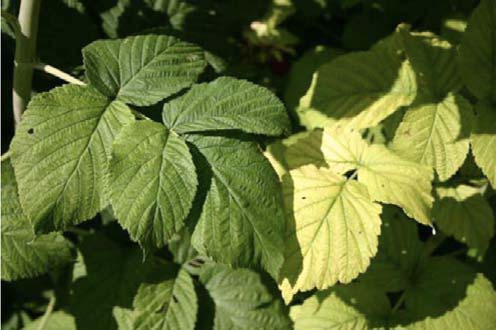
Iron chlorosis is a symptom of iron deficiency. It is common in many Utah berry crops and is characterized by inter-veinal yellowing (Figure 7). Iron chlorosis can be easily recognized by the yellowing of the younger leaves while the veins remain a darker green color. In severe cases, the entire leaf can turn a yellow-white color and then begin browning on the edges. Although Utah soils contain iron, the high pH makes the iron unavailable to plants. Successive years of iron chlorosis will result in weakened plants that will be more susceptible to diseases and insects.
To minimize iron chlorosis occurrence, it is important to use proper management techniques. Avoid overfertilizing with nitrogen. Large amounts of nitrogen will stimulate excessive vegetative growth, and the plant cannot take up enough iron to meet the need by the new growth. Over-irrigation, especially in the early spring, also induces iron deficiency. Cold, waterlogged roots are not effective in iron uptake. Wait to begin irrigation until the top foot of soil is dry. Adding a chelated iron amendment to the soil or directly to the leaves of the plants can help, but is relatively expensive. Foliar application of chelates provides a very short term but rapid response. Best results will be obtained by soilapplied chelated iron twice in the growing season, once in May and again in September. More information on iron chlorosis in berry crops is available at http://extension.usu.edu/files/publications/publication/H orticulture_Fruit_2009-02pr.pdf.
Irrigation
Watering too early in the season cools the soil, slows root growth, causes poor aeration, and induces iron chlorosis. Once irrigation is needed, apply 1 to 2 inches of water per week. During fruiting, plants may need additional water to promote larger berries. Actively growing raspberry roots will die if submerged in water or subjected to water-logged soils for 24 hours or more. Raspberries are shallow rooted and regular watering is critical to prevent soil drying. During the hottest part of the summer, twice-weekly irrigation may be needed. Soil moisture can be monitored with a tensiometer or electrical resistance block, although for the home gardener these systems may be excessive. For additional irrigation information see USU fact sheet Horticulture_Fruit_2008-04pr.
Mulches
Apply organic mulch after the soil has warmed in the spring to conserve moisture, reduce weed growth and improve the soil. Common mulches include straw, sawdust, bark chips, shredded paper and compost. For raspberry production, plastic mulches or weed barrier fabrics are not recommended because they prevent primocane emergence from the roots.
Trellising

Trellising is required to reduce cane breakage, to keep fruit off the ground and make harvesting easier. Raspberries can be trellised in many different ways, so it is important to build trellises to fit your situation and your budget. A simple T-trellis system, as pictured in Figure 8, works well for summer bearing raspberries.
Pruning Summer-Bearing Red Raspberries
Summer-bearing red raspberries can be pruned in the fall after most of the floricane leaves have dropped, or in the early spring before they start growing. Some growers prune in the fall as they believe that this reduces winter injury to the remaining canes. Pruning involves four steps: (1) Remove all spent floricanes at ground level. (2) Narrow the rows by cultivation. (3) Thin the remaining canes removing weak and damaged or broken canes, leaving no more than 4 to 6 canes per foot of row. (4) Topping or cutting back the remaining canes. Topping the canes reduces the total amount of fruit that will be produced, but the remaining fruit will be larger. If the primary interest is in processing the fruit into jams and jellies, then leaving the canes untopped will produce the greatest amount of fruit, but fruit size will tend to be smaller. Commercial producers that want large fruit for fresh market sales will cut the canes back leaving only 3 to 5 feet of cane, depending on cultivar and plant vigor.
Pruning Fall-bearing Raspberries
Fall-bearing (primocane-fruiting) raspberries have two acceptable pruning methods. If you are only interested in a fall crop, the canes can be cut off at the ground each year during the dormant season. Rows should also be narrowed to 2 to 3 feet by cultivation, although rows for fall bearers are typically left wider than for summer-summerbearing types. If both a summer and a fall crop is desired, then prune as recommended for summer bearers (remove spent canes and thin remaining canes). Canes should be topped just below the lowest flower cluster from the previous year, see Figure 3. Typically, double cropping results in a smaller fall crop than would result if the canes were cut to the ground each year.
Raspberry Pests
Insect
A healthy planting of raspberries is less likely to be attacked and can withstand some insect damage better than an unhealthy one. Properly managing irrigation, fertilization and selecting cultivars well suited for Utah can be a great pest defense. Keeping weed populations low and removing pruning from the site will also help to combat insect occurrence.
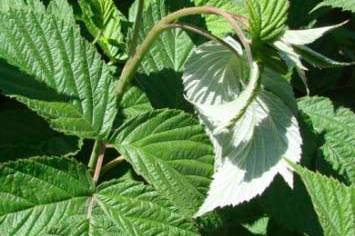
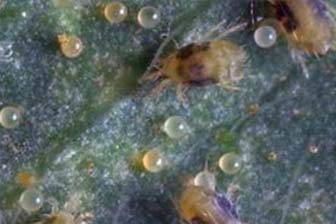
One of the most important parts of managing insect pests is to carefully monitor raspberry plantings. Early detection can help limit damage. After detecting a pest presence, correctly identifying the pest is critical. For identification assistance, contact your local county Extension agent or submit a sample to the Utah Plant Pest Diagnostic Lab (utahpests.usu.edu/). Table 3 lists common raspberry pests in Utah and control options.
| Table 3. Common raspberry insect pests in Utah. | ||||
|---|---|---|---|---|
| Pest | Description | Damage | Control | |
| Larger Raspberry Aphid | Soft-bodied, fluid sucking insect. Overwinters as eggs on canes and has many generations per year. | Suck plant sap, stunting vegetative and fruit growth and can spread diseases. | Monitor closely, checking under leaves. Encourage beneficial insects (such as lady beetles) and avoid applying pesticides that will damage them. Insecticidal soaps or oils should be used if plant health declines. | |
| Raspberry Crown Borer | Clear-wing moth that looks like a yellowjacket. White larvae with brown head. Has a 2- year life cycle. | Canes weaken and often break off. Cane ends look like a shepherd's crook and eventually the entire cane dies back. | Dig out and destroy affected canes and roots. Drench soil and crown with bifenthrin, diazinon, or imidacloprid in early fall. | |
| Raspberry Horntail (Cane Borer) (Fig. 9) | Adult is a black wasp about 1'' long. White larvae grows to 1'' and has a brown head. | Bores in the canes, causing cane dieback from tip down. Cane dieback occurs from June to August. | Spray with registered insecticide (Rotenone+Pyrethrin, Carbaryl, diazinon, malathion) at bud break and 14 days later. Cut below affected part of cane and destroy. | |
| Root Weevils | Small black nightfeeding beetle. | Reduced fruit yields and even cane death. | Apply baits, use traps or parasitic nematodes. Apply registered insecticides if damage is severe. | |
| Rose Stem Girdler (Cane Girdler) | Beetles less than 0.25'' long with dark copper to greenish copper color. White, flat larva 0.5'' long | Larvae feed inside primocanes, girdling them and causing swollen stem galls. | Prune and destroy infested canes. Spray entire cane before bloom with registered insecticides (Carbaryl, pyrethrin, malathion, befenthrin). | |
| Two-spotted Spider Mite (Fig. 10) | Very small, 0.02'' yellow mite with two dark spots on back forms colonies and webbing on undersides of leaves. 10 to 14 day life cycle. | Suck plant sap, leaving fine, gray stippling on leaves, starting on lower leaves and moving up. Large infestations form visible webbing. Reduces cane vigor and yield. Heavy feeding leads to death of leaves. | Mites favor hot, dry conditions. Minimize dust and control weeds, particularly broadleaf, around the field. Keep plants well watered to avoid stress. Promote predatory mites and other predators. Avoid insecticides that will harm beneficial insects. | |
Disease
Diseases typically cause more serious damage than insect pests and control is more difficult. Depending on the disease, it is sometimes necessary to remove the planting and start over. Therefore, prevention is the best control option. Planting cultivars that have a natural resistance to the disease is very effective, however, not always possible. Keeping the plants healthy and avoiding conditions that favor infection is key. Table 4 lists common diseases in Utah.
| Table 4. Common raspberry diseases in Utah. | ||||
|---|---|---|---|---|
| Disease | Symptoms | Control | ||
| Crown and Root Gall | Bacteria in the soil invades the plants and cause development of tumor like masses on roots and crowns. Results in weak growth and reduced production. | Plant disease-free stock and do not plant into infected soil. No effective eradication method. | ||
| Gray Mold (Botrytis) | Spores are almost always present and will infect ripe fruit and blossoms when moisture and temperature conditions are right. Infected fruit rapidly becomes watery and soft, tiny, black or gray spores develop on surface of fruit. | If using sprinkler irrigation, water in the morning to allow time for plants to dry during the day. Trellis plants to have an open canopy with good air movement. Cool fruit immediately after harvest. If conditions are favorable for development, apply registered fungicidal spray. | ||
| Phytophthora Root Rot | Wilting and dieback of top of canes. Increases in severity until plants die. Dark, water-soaked region at base and roots. Crown are reddish-brown when scraped. | Plant resistant cultivars. Plant into uncontaminated soil. Avoid heavy wet soils or plant into raised beds. | ||
| Powdery Mildew | Tops of leaves turn blotchy yellow and underside is covered with white powdery fungal growth. Develops in warm, dry weather. | Plant resistant cultivars. Mild infections do not warrant chemical control. Remove infected shoots during late summer to reduce further infection. | ||
Virus

Viruses are systemic, meaning they travel throughout the entire plant and affect every part of it. Once a plant in the field is infected, it is not possible to eliminate the virus. The only control method is to remove and destroy the infected plant and isolate the surrounding healthy plants from sources of infection. The most serious viruses in our area are Bushy Dwarf and Mosaic (see Table 5).
Crumbly fruit is a result of poor or incomplete pollination leading to reduced numbers of drupelets. There are several factors that can prevent adequate drupelet formation and cause fruit to crumble. A virus can be the cause of this crumbling, but is not the only possibility. If your planting has crumbly fruit, be sure to check for other symptoms before deciding it is a virus and taking control measures. Weakened plants become targets for raspberry viruses and they fail to harden adequately, resulting in winter injury.
| Table 5. Common raspberry viruses in Utah. | |||
|---|---|---|---|
| Virus | Transmission | Symptoms | Control |
| Mosaic | Amphoraphora agathonica aphid | Delayed leafing out. Small, misshapen leaves, mottling or large green blisters. | Plant aphid resistant cultivars. Control aphid populations in the planting. |
| Raspberry Bushy Dwarf | Pollen | Crumbly fruit, yellow, irregular, misshapen leaves. | Plant virus free, resistant cultivars. |
| Leaf Curl | Aphis rubicola | Small leaves, tips and margins turn downward. Fruiting laterals shortened. | Plant virus free, resistant cultivars. |
| Tomato Ringspot | Xiphinema americanum Nematode | Crumbly fruit, pale ringspots on leaves in spring, followed by yellowing of leaves and overall stunted growth. | Plant virus free, resistant cultivars. Rotate to non-host species. |
Raspberry Harvest, Storage, and Use
Raspberries are harvested over a 2 to 4 week period, depending on the cultivar. Unfortunately, berry quality can quickly decline once harvested. It is best to pick in the early morning before the afternoon heat. Cool berries as soon as possible after harvesting by placing them in a refrigerator or other cool place, this will extend their shelf life. During peak production, raspberries need to be harvested once every 2 days. Typical yields for raspberry plantings in Utah are approximately 1 pound per linear foot of row each season. Handle fruit carefully to avoid bruising. Fruit can be stored for up to 5 days if properly handled. Raspberries can be eaten fresh, preserved as jam or jelly or used in baking.
References
- Alston, D. 2011. Raspberry cane insects. USU Extension, Logan Utah. http://utahpests.usu.edu/htm/utah-pestsnews/ fall2011/raspberry-damage/
- Alston, D., B. Black and M. Murray. 2009. Raspberry horntail. USU Extension, Logan Utah. http://utahpests.usu.edu/ipm/htm/fruits/fruit-insectdisease/raspberry-horntail09
- Black, B., G. Cardon and C. Ransom. 2009. Iron Chlorosis in Berries. USU Extension, Logan Utah. http://extension.usu.edu/files/publications/publication/Horticulture_Fruit_2009-02pr.pdf
- Black, B., R. Hill and G. Cardon. 2008. Caneberry Irrigation. USU Extension, Logan Utah. http://extension.usu.edu/files/publications/publication/Hor ticulture_Fruit_2008-04pr.pdf
- Crandall, P.C. 1995. Bramble production: The management and marketing of raspberries and blackberries. Haworth Press, Inc. New York.
- Hunter, B. R. Heflebower, S. Olsen, B. Black, D. Alston and T. Lindstrom. 2015. A comparison of 16 Summer-bearing raspberry cultivars for Northern Utah. USU Extension, Logan Utah http://extension.usu.edu/files/publications/publication/Hor ticulture_Fruit_2015-02pr.pdf
- Helflebower, R. B. Hunter, S. Olsen, B. Black, D. Alston and T. Lindstrom. 2013. A comparison of 10 fall-bearing raspberry cultivars for Northern Utah. USU Extension, Logan Utah. http://extension.usu.edu/files/publications/publication/Hor ticulture_Fruit_2013n-01pr.pdf
Utah State University Extension
Peer-reviewed fact sheet
Download PDF
Authors
Tiffany Maughan, Research Associate, and Brent Black, Extension Fruit Specialist
Related Research



